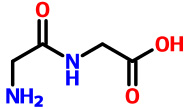Welcome to Peptide Guide!
The first synthetic peptide A peptide is a chemical compound containing two or more amino acids (amino acid polymers) that are coupled by a peptide bond. This bond is a special linkage in which the nitrogen atom of one amino acid binds to the carboxyl carbon atom of another. Peptides are often classified according to the number of amino acid residues. Oligopeptides have 10 or fewer amino acids. Molecules consisting from 10 to 50 amino acids are called peptides. The term protein describes molecules with more than 50 amino acids. Molecules with molecular weights ranging from several thousand to several million daltons (D) are called polypeptides. The terms polypeptide and protein are frequently used interchangeably. In 1901, the first synthetic peptide glycyl-glycine (see picture) was discovered by Emil Fischer, in collaboration with Ernest Fourneau. The first polypeptide (oxytocin - nine amino acid sequence) was synthesized by Vincent du Vigneaud in 1953. Peptides have a wide range of applications in medicine and biotechnology. They regulate most physiological processes, acting at some sites as endocrine or paracrine signals and at others as neurotransmitters or growth factors. Insulin was the first therapeutic protein to be introduced to treat insulin-dependent diabetes in the 1920s. There are sixty FDA approved peptide drugs in the market. About 140 peptide drugs are in clinical trials and over 500 are in pre-clinical development. A number of peptides are used for diagnostic purposes, for example C-peptide is used to monitor insulin production and to help determine the cause of low blood sugar (hypoglycemia). Peptides are synthesized by coupling the carboxyl group or C-terminus of one amino acid to the amino group or N-terminus of another. There are two strategies for peptide synthesis: liquid-phase peptide synthesis and solid-phase peptide synthesis (SPPS). The goal of this project is to collect all information about peptides and peptide synthesis in one place. |
||
|
||